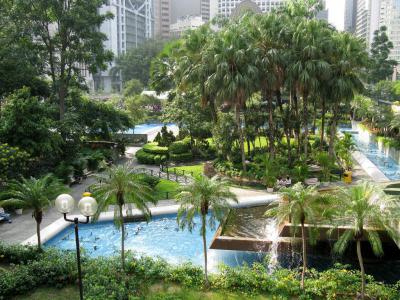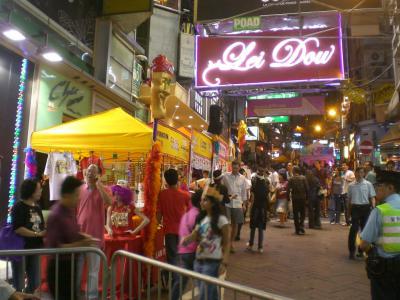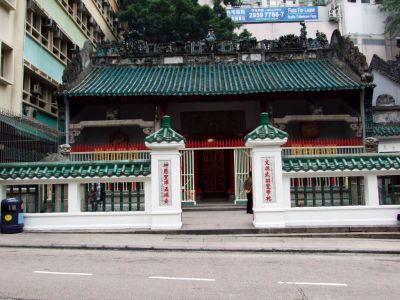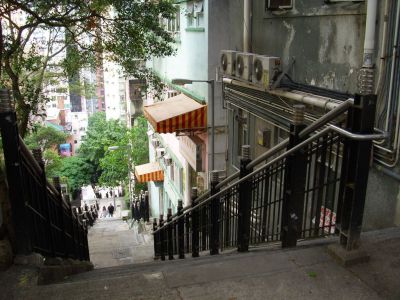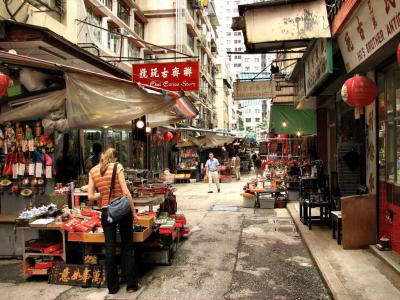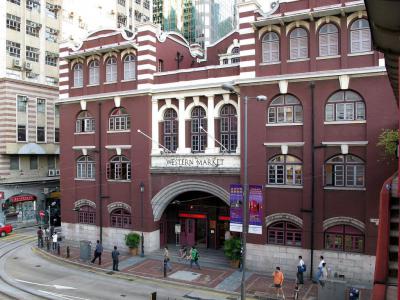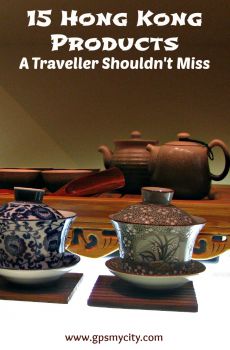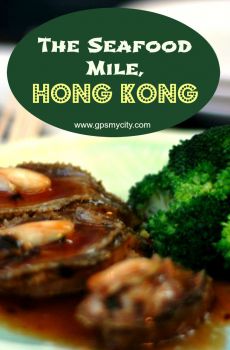
Downtown Introduction Walking Tour (Self Guided), Hong Kong
Hong Kong has a long, storied history, that stretches back centuries. However, much of what we associate with today's Hong Kong is more recent in nature.
At the end of the First Opium War, in 1842, the Qing Dynasty ceded control of the region to the British who colonized and westernized it, creating businesses and building roads, schools, and churches. Throughout 155 years of British rule, the area enjoyed economic success, ultimately becoming a global financial center, whilst, at the same time, preserving its unique cultural heritage.
The name "Hong Kong" originates from the Cantonese language, meaning "Fragrant Harbor" or "Incense Harbor." This may refer either to the sweet taste of the harbor's freshwater influx from the Pearl River or to the odor from incense factories that once lined the coast.
In 1997, the British returned Hong Kong to China. Nonetheless, the city remains a special administrative region within China, mostly autonomous from mainland China. With its own government, legal system, education, and currency, Hong Kong has greater control than a typical Chinese city but less autonomy than a sovereign nation.
Downtown Hong Kong, often simply referred to as "Central," is a vibrant district at the heart of the city. One of its gems is Hong Kong Park, a serene oasis amid the urban jungle.
Saint John's Cathedral, a stunning Anglican church, built in the mid-19th century, showcases exquisite Gothic architecture and serves as a reminder of Hong Kong's colonial past.
Statue Square, another prominent landmark, is home to several bronze statues, including a tribute to Queen Victoria. It's a popular gathering place and often hosts various events.
Venturing deeper into Downtown, you'll find Li Yuen Street East, known for its bustling street markets where you can shop for affordable fashion and trinkets.
Lan Kwai Fong, a vibrant nightlife district, comes alive after sunset with numerous bars and restaurants, making it the perfect spot for those seeking entertainment and a lively atmosphere.
For a taste of local life, the Graham Street Wet Market offers fresh produce and a glimpse into Hong Kong's culinary traditions. The Central Mid-Levels Escalators, a unique transportation system, connects the lower and upper parts of the Central and provides spectacular views of the city.
Undoubtedly, Downtown Hong Kong caters to a diverse range of interests. We therefore encourage you to explore it in your good time and immerse yourself in its vibrant culture with the help of our self-guided tour. So, plan your visit now and embark on this fascinating journey.
At the end of the First Opium War, in 1842, the Qing Dynasty ceded control of the region to the British who colonized and westernized it, creating businesses and building roads, schools, and churches. Throughout 155 years of British rule, the area enjoyed economic success, ultimately becoming a global financial center, whilst, at the same time, preserving its unique cultural heritage.
The name "Hong Kong" originates from the Cantonese language, meaning "Fragrant Harbor" or "Incense Harbor." This may refer either to the sweet taste of the harbor's freshwater influx from the Pearl River or to the odor from incense factories that once lined the coast.
In 1997, the British returned Hong Kong to China. Nonetheless, the city remains a special administrative region within China, mostly autonomous from mainland China. With its own government, legal system, education, and currency, Hong Kong has greater control than a typical Chinese city but less autonomy than a sovereign nation.
Downtown Hong Kong, often simply referred to as "Central," is a vibrant district at the heart of the city. One of its gems is Hong Kong Park, a serene oasis amid the urban jungle.
Saint John's Cathedral, a stunning Anglican church, built in the mid-19th century, showcases exquisite Gothic architecture and serves as a reminder of Hong Kong's colonial past.
Statue Square, another prominent landmark, is home to several bronze statues, including a tribute to Queen Victoria. It's a popular gathering place and often hosts various events.
Venturing deeper into Downtown, you'll find Li Yuen Street East, known for its bustling street markets where you can shop for affordable fashion and trinkets.
Lan Kwai Fong, a vibrant nightlife district, comes alive after sunset with numerous bars and restaurants, making it the perfect spot for those seeking entertainment and a lively atmosphere.
For a taste of local life, the Graham Street Wet Market offers fresh produce and a glimpse into Hong Kong's culinary traditions. The Central Mid-Levels Escalators, a unique transportation system, connects the lower and upper parts of the Central and provides spectacular views of the city.
Undoubtedly, Downtown Hong Kong caters to a diverse range of interests. We therefore encourage you to explore it in your good time and immerse yourself in its vibrant culture with the help of our self-guided tour. So, plan your visit now and embark on this fascinating journey.
How it works: Download the app "GPSmyCity: Walks in 1K+ Cities" from Apple App Store or Google Play Store to your mobile phone or tablet. The app turns your mobile device into a personal tour guide and its built-in GPS navigation functions guide you from one tour stop to next. The app works offline, so no data plan is needed when traveling abroad.
Downtown Introduction Walking Tour Map
Guide Name: Downtown Introduction Walking Tour
Guide Location: Hong Kong » Hong Kong (See other walking tours in Hong Kong)
Guide Type: Self-guided Walking Tour (Sightseeing)
# of Attractions: 13
Tour Duration: 2 Hour(s)
Travel Distance: 3.7 Km or 2.3 Miles
Author: emma
Sight(s) Featured in This Guide:
Guide Location: Hong Kong » Hong Kong (See other walking tours in Hong Kong)
Guide Type: Self-guided Walking Tour (Sightseeing)
# of Attractions: 13
Tour Duration: 2 Hour(s)
Travel Distance: 3.7 Km or 2.3 Miles
Author: emma
Sight(s) Featured in This Guide:
- Hong Kong Park
- St. John's Cathedral
- Chater Garden
- Statue Square
- Li Yuen Street East
- Lan Kwai Fong
- Graham Street Wet Market
- Central Mid-Levels Escalators
- Man Mo Temple
- Ladder Street
- Cat Street Market
- Possession Street
- Western Market
1) Hong Kong Park (must see)
Hong Kong Park is a public park taking up 8.16 hectares in central Hong Kong. Prior to its usage as a park, the area belonged to Glenealy Junior School. The land was gifted to the school by the government as this was the former site of the Victoria Barracks.
Hong Kong Park continues to pay homage to the area's history with a number of historic buildings onsite. Flagstaff House was built in 1846 as the home for the commander of the British forces in Hong Kong. It is the oldest Greek Revival Style building in the region. Visitors are welcome in Flagstaff House, which now houses the Museum of Teaware.
Other buildings on the premises include Rawlinson House, Wavell House and Cassels Block, a former barracks that is now home to the Hong Kong Visual Arts Centre.
The park includes a multi-level children's playground, the Olympic Square and a clock tower. There are multiple gardens, including the Central Garden with its dancing fountain, and an aviary.
The aviary has birds like the long-tailed broadbill, the wompoo fruit dove, the Victoria crowned pigeon and the great white pelican. Visitors are welcome to walk through the aviary as they gaze at the birds and trees.
Hong Kong Park continues to pay homage to the area's history with a number of historic buildings onsite. Flagstaff House was built in 1846 as the home for the commander of the British forces in Hong Kong. It is the oldest Greek Revival Style building in the region. Visitors are welcome in Flagstaff House, which now houses the Museum of Teaware.
Other buildings on the premises include Rawlinson House, Wavell House and Cassels Block, a former barracks that is now home to the Hong Kong Visual Arts Centre.
The park includes a multi-level children's playground, the Olympic Square and a clock tower. There are multiple gardens, including the Central Garden with its dancing fountain, and an aviary.
The aviary has birds like the long-tailed broadbill, the wompoo fruit dove, the Victoria crowned pigeon and the great white pelican. Visitors are welcome to walk through the aviary as they gaze at the birds and trees.
2) St. John's Cathedral
There are only five cathedrals in all of Hong Kong. The oldest is the Cathedral Church of Saint John the Evangelist, otherwise known as Saint John's Cathedral. Like Holy Trinity Cathedral and All Saints' Cathedral, Saint John's is Anglican. The other two Hong Kong cathedrals are the Cathedral of the Immaculate Conception and Saint Luke's Orthodox Cathederal, which are Roman Catholic and Eastern Orthodox, respectively.
Saint John's Cathedral was completed in 1849 and consecrated in 1852. It is not just the oldest cathedral in Hong Kong but the oldest Anglican church in the Far East. The architectural style is English Gothic Revival. The cathedral is fashioned from stucco and wood.
Visitors to Hong Kong are welcome to attend services at Saint John's Cathedral. It is open for regular services on Saturdays and Sundays. On Mondays, the cathedral hosts a meditation service from 12:30 to 1 PM.
The cathedral grounds have ample seating for those who want to enjoy some peace and relaxation in the midst of the bustling Garden Road. Adjacent to Saint John's Cathedral is Cheung Kong Park, which offers excellent views of the cathedral's clock tower while providing a quiet walking path lined with greenery.
Why You Should Visit:
Exquisite church in the heart of the city jungle with peaceful and pretty courtyard seating.
Tip:
Very often, you will find Wednesday lunchtime performances. There's even a cafe on the grounds called The Nest with a lovely selection of hot & cold drinks, biscuits, pies, etc.
Saint John's Cathedral was completed in 1849 and consecrated in 1852. It is not just the oldest cathedral in Hong Kong but the oldest Anglican church in the Far East. The architectural style is English Gothic Revival. The cathedral is fashioned from stucco and wood.
Visitors to Hong Kong are welcome to attend services at Saint John's Cathedral. It is open for regular services on Saturdays and Sundays. On Mondays, the cathedral hosts a meditation service from 12:30 to 1 PM.
The cathedral grounds have ample seating for those who want to enjoy some peace and relaxation in the midst of the bustling Garden Road. Adjacent to Saint John's Cathedral is Cheung Kong Park, which offers excellent views of the cathedral's clock tower while providing a quiet walking path lined with greenery.
Why You Should Visit:
Exquisite church in the heart of the city jungle with peaceful and pretty courtyard seating.
Tip:
Very often, you will find Wednesday lunchtime performances. There's even a cafe on the grounds called The Nest with a lovely selection of hot & cold drinks, biscuits, pies, etc.
3) Chater Garden
Surrounded by famous structures and places such as the Bank of China Tower, the Legislative Council Building and situated to the south of the Hong Kong Planning and Infrastructure Gallery, Chater Garden is one of the easiest sites to find in the Central area.
It is named after Sir Paul Chater, a prominent British-Indian businessman of Armenian descent, and on one side of the garden is Chater Road which is also named after him. It is the perfect choice to rest and admire its arranged pools, waterfalls and fountains, as well as well-maintained and manicured bushes.
The garden is often used for holding political rallies and demonstrations due to its proximity to the seat of government. Chater Garden took up space left by the Hong Kong Cricket Club, which was located there from 1851 to 1975. The garden was re-developed and was formally opened to public in 1978.
It is named after Sir Paul Chater, a prominent British-Indian businessman of Armenian descent, and on one side of the garden is Chater Road which is also named after him. It is the perfect choice to rest and admire its arranged pools, waterfalls and fountains, as well as well-maintained and manicured bushes.
The garden is often used for holding political rallies and demonstrations due to its proximity to the seat of government. Chater Garden took up space left by the Hong Kong Cricket Club, which was located there from 1851 to 1975. The garden was re-developed and was formally opened to public in 1978.
4) Statue Square
Statue Square is a pedestrian square located in the center of Hong Kong. It is located between Chater Road and Des Voeox Road Central. Statue Square is in a busy shopping area that is a short, one minute walk from Chater Park. It is also near the Centopah, a monument that memorializes those killed in wars.
The name of Statue Square may be confusing to a new tourist to the city. Visitors may think it is named after the only statue in the square, which is that of Sir Thomas Jackson. In reality, the square is so-named because it was once home to a number of statues of British royalty, the first of which was Queen Victoria. During World War II, occupying forces from Japan removed the statues.
Other statues that were once in the square included Prince Albert, the Duke of Connaught, King Edward VII, King George V, Queen Alexandra, Mary of Teck, Henry May and a statue commemorating World War I titled "Fame."
The name of Statue Square may be confusing to a new tourist to the city. Visitors may think it is named after the only statue in the square, which is that of Sir Thomas Jackson. In reality, the square is so-named because it was once home to a number of statues of British royalty, the first of which was Queen Victoria. During World War II, occupying forces from Japan removed the statues.
Other statues that were once in the square included Prince Albert, the Duke of Connaught, King Edward VII, King George V, Queen Alexandra, Mary of Teck, Henry May and a statue commemorating World War I titled "Fame."
5) Li Yuen Street East
Li Yuen Street East, situated in the Central district of Hong Kong Island, holds historical significance as the first street in colonial Hong Kong named after a Chinese member of society. Today, it has transformed into a bustling tourist destination, attracting visitors with its vibrant atmosphere and an array of stalls offering diverse daily goods and souvenirs.
In the late 18th century, ambitious land reclamation projects aimed to expand the downtown area and meet the growing demand for land. As a result, sizable portions of newly reclaimed land became available for purchase. Seizing this opportunity, Kim Li Yuen, a prosperous businessman from Guangdong Province in China, acquired a section of the reclaimed land for property development. In 1894, the street derived its name from him and became known as Li Yuen Street East.
In its early days, the street had both residential and commercial buildings. Shops were on the ground floors and apartments above. However, the famous street stalls of Li Yuen Street East were not present at that time. After World War II, newspaper offices and printing workshops were set up on the street. As a result, it became known as "Newspaper Street." Newspapers were manually distributed from this street to the rest of Hong Kong every morning.
The newspaper offices moved, making room for a new era on Li Yuen Street East. Clothing stalls emerged and expanded their offerings as more tourists came. Today, visitors find a variety of goods like clothing, accessories, and souvenirs.
In the late 18th century, ambitious land reclamation projects aimed to expand the downtown area and meet the growing demand for land. As a result, sizable portions of newly reclaimed land became available for purchase. Seizing this opportunity, Kim Li Yuen, a prosperous businessman from Guangdong Province in China, acquired a section of the reclaimed land for property development. In 1894, the street derived its name from him and became known as Li Yuen Street East.
In its early days, the street had both residential and commercial buildings. Shops were on the ground floors and apartments above. However, the famous street stalls of Li Yuen Street East were not present at that time. After World War II, newspaper offices and printing workshops were set up on the street. As a result, it became known as "Newspaper Street." Newspapers were manually distributed from this street to the rest of Hong Kong every morning.
The newspaper offices moved, making room for a new era on Li Yuen Street East. Clothing stalls emerged and expanded their offerings as more tourists came. Today, visitors find a variety of goods like clothing, accessories, and souvenirs.
6) Lan Kwai Fong
Lan Kwai Fong is a small square of streets and a popular tourist area in Hong Kong for dining, drinking and clubbing. Originally this area had been dedicated to hawkers before World War II but during the mid-1980s, it underwent a renaissance.
During the early days, Lan Kwai Fong square had housed many marriage arrangers, a role exclusively held by women. Back then the area was also called Medium Person Lane.
In 1983 a Canadian businessman Allan Zeman opened a California restaurant in Lan Kwai Fong. After the success of his restaurant, Allan Zeman purchased an entire block in the area and transformed it to a entertainment destination for tourists as well as expatriates. The street became well known after Zeman's involvement and today he is referred to as “The Father of Lan Kwai Fong”.
Why You Should Visit:
One of the best places in the world for bar hopping, club hopping all night, every day. Locals and tourists flock here for the nightlife.
Tip:
Go before 9 pm and you can enjoy food & drinks at very reasonable prices.
During the early days, Lan Kwai Fong square had housed many marriage arrangers, a role exclusively held by women. Back then the area was also called Medium Person Lane.
In 1983 a Canadian businessman Allan Zeman opened a California restaurant in Lan Kwai Fong. After the success of his restaurant, Allan Zeman purchased an entire block in the area and transformed it to a entertainment destination for tourists as well as expatriates. The street became well known after Zeman's involvement and today he is referred to as “The Father of Lan Kwai Fong”.
Why You Should Visit:
One of the best places in the world for bar hopping, club hopping all night, every day. Locals and tourists flock here for the nightlife.
Tip:
Go before 9 pm and you can enjoy food & drinks at very reasonable prices.
7) Graham Street Wet Market
Graham Street Wet Market is one of Hong Kong's oldest street markets. It has been in operation for about 160 years, though this may be short-lived. Plans to demolish the market are regularly proposed. Though none have been successful, tourists should make sure to visit the Graham Street Wet Market before it's too late.
Don't let the name of the market fool you. Graham Street Market does not solely belong to its namesake street. There are plenty of market stalls on Gage, Peel and Stanley streets. The open-air market stalls line the narrow streets with offerings like fresh fruit, herbs and flowers.
Graham Street Market is an excellent place to stop for lunch. Noodle stands, bakeries and other ready-made street food is available. Those who have access to kitchens may want to buy some fresh meat or seafood. Tourists shop alongside locals at the Graham Street Market, which makes for a memorable and authentic experience.
Don't let the name of the market fool you. Graham Street Market does not solely belong to its namesake street. There are plenty of market stalls on Gage, Peel and Stanley streets. The open-air market stalls line the narrow streets with offerings like fresh fruit, herbs and flowers.
Graham Street Market is an excellent place to stop for lunch. Noodle stands, bakeries and other ready-made street food is available. Those who have access to kitchens may want to buy some fresh meat or seafood. Tourists shop alongside locals at the Graham Street Market, which makes for a memorable and authentic experience.
8) Central Mid-Levels Escalators
The Central-Mid-levels escalators are the longest, covered outdoor escalator system in the world. They cover over eight hundred meters in distance and elevate over one hundred and thirty five meters from bottom to top. The system was constructed in 1993 in order to provide an easier commute by linking the Western and Central Districts on Hong Kong Island.
The Island of Hong King consists of steep and hilly terrain, which makes it difficult for residents and tourists’ alike to commute up and down the slopes. Due to this reason, Hong Kong has many unusual and unique systems of transport in order to facilitate its citizens and tourists as well.
The elevator system was officially opened on the 15th of October in 1993. Ever since then, it has played a key role in making the Western District pedestrian friendly. Passing through narrow streets, the system links Des Voeux Road in the Central district of Hong Kong with Conduit Road in the Mid-levels. It usually has a daily traffic of over 50,000 people. Although the total travel time is twenty minutes from one end of the system to the other, most people walk while the escalators are moving in order to shorten their trip.
The Island of Hong King consists of steep and hilly terrain, which makes it difficult for residents and tourists’ alike to commute up and down the slopes. Due to this reason, Hong Kong has many unusual and unique systems of transport in order to facilitate its citizens and tourists as well.
The elevator system was officially opened on the 15th of October in 1993. Ever since then, it has played a key role in making the Western District pedestrian friendly. Passing through narrow streets, the system links Des Voeux Road in the Central district of Hong Kong with Conduit Road in the Mid-levels. It usually has a daily traffic of over 50,000 people. Although the total travel time is twenty minutes from one end of the system to the other, most people walk while the escalators are moving in order to shorten their trip.
9) Man Mo Temple
Man Mo Temple is a temple to two gods: Man Tai and Mo Tai. Man Tai is the Taoist God of Culture and Literature. Mo Tai is the God of War. There are numerous temples to these two gods located throughout Hong Kong. This one is the most famous among them.
Located on Hollywood Road, it is the largest and oldest Man Mo Temple in Hong Kong. The temple was built in 1847 and represents Qing Dynasty architecture with a distinctive green tiled roof and ornate carvings.
The temple remains in use, and therefore visitors are welcome to enter at no charge. Inside, tourists will see incense coils, wooden carvings, golden statues, hanging lanterns and a traditional Taoist fortune teller.
The Man Mo Temple complex includes Litt Shing Kung, a temple dedicated to all gods, and Kung Sor, a meeting space. Other Man Mo Temples around the city that may be worth a visit are Tai Po on Fu Shin Street and Lantau in the Pak Nguan Heung neighborhood of Hong Kong's Lantau Island.
Located on Hollywood Road, it is the largest and oldest Man Mo Temple in Hong Kong. The temple was built in 1847 and represents Qing Dynasty architecture with a distinctive green tiled roof and ornate carvings.
The temple remains in use, and therefore visitors are welcome to enter at no charge. Inside, tourists will see incense coils, wooden carvings, golden statues, hanging lanterns and a traditional Taoist fortune teller.
The Man Mo Temple complex includes Litt Shing Kung, a temple dedicated to all gods, and Kung Sor, a meeting space. Other Man Mo Temples around the city that may be worth a visit are Tai Po on Fu Shin Street and Lantau in the Pak Nguan Heung neighborhood of Hong Kong's Lantau Island.
10) Ladder Street
Ladder Street is a street consisting entirely of stone steps located in Sheung Wan in Hong Kong. The street is also called Lau Tai Gai (which translates to ‘ladder’). This is a popular tourist spot due to its historic significance in Hong Kong. Negotiating the many steps up the street is a difficult task, but one that can be enjoyed greatly due to the sights and sounds that the street has to offer.
The Man Mo Temple located at the corner of Ladder Street on Hollywood Road is one of the most visited temples by both tourists and locals in Hong Kong. The Tung Wah Hospital, which is the oldest western hospital in Hong Kong, is also located on the street. Many funeral homes, which are more than a century old, are located on this street. The shops that housed the funeral homes were called "long-living shops" and “four-and-a-half-piece” shops by local people.
The ladder street begins on Queens Road and continues up to Sheung Wan mid-levels. The street is full of color and history and apart from the much visited Man Mo Temple; the Museum of Medical Science is also located on the street. The street has remained unchanged since the middle of the 20h century, but the buildings surrounding the street have been demolished and rebuilt extensively.
The Man Mo Temple located at the corner of Ladder Street on Hollywood Road is one of the most visited temples by both tourists and locals in Hong Kong. The Tung Wah Hospital, which is the oldest western hospital in Hong Kong, is also located on the street. Many funeral homes, which are more than a century old, are located on this street. The shops that housed the funeral homes were called "long-living shops" and “four-and-a-half-piece” shops by local people.
The ladder street begins on Queens Road and continues up to Sheung Wan mid-levels. The street is full of color and history and apart from the much visited Man Mo Temple; the Museum of Medical Science is also located on the street. The street has remained unchanged since the middle of the 20h century, but the buildings surrounding the street have been demolished and rebuilt extensively.
11) Cat Street Market
The Cat Street Market is located on Upper Lascar Row and is a popular tourist spot.
The market sells antiques, beautiful paintings, and even replicas of antiques and original paintings (Tourists should watch out for duplicate pieces). Usually the antiques include jade carvings, expensive Ming vases and snuff bottles, as well as Mao memorabilia. The market has an overall a flea-market like atmosphere. One can also find Chinese souvenirs like old Hong Kong post cards, posters and also fake, antique watches.
Carpet shops and ceramic shops abound on Cat Street, with carpets imported from India and The Middle East. Furniture can also be found on the market. Many stalls, full of “Red” themed Mao memorabilia line the street, and most tourists can find unusual and unique books, pictures and even relics from the 1950s era when the Peoples Republic of China had recently come to power. Unlike the expensive shops in Kowloon, the Cat Street Market is a place to purchase bargain goods. Most imported goods that are found here are tax free, and bargaining can save buyers even more money.
The market sells antiques, beautiful paintings, and even replicas of antiques and original paintings (Tourists should watch out for duplicate pieces). Usually the antiques include jade carvings, expensive Ming vases and snuff bottles, as well as Mao memorabilia. The market has an overall a flea-market like atmosphere. One can also find Chinese souvenirs like old Hong Kong post cards, posters and also fake, antique watches.
Carpet shops and ceramic shops abound on Cat Street, with carpets imported from India and The Middle East. Furniture can also be found on the market. Many stalls, full of “Red” themed Mao memorabilia line the street, and most tourists can find unusual and unique books, pictures and even relics from the 1950s era when the Peoples Republic of China had recently come to power. Unlike the expensive shops in Kowloon, the Cat Street Market is a place to purchase bargain goods. Most imported goods that are found here are tax free, and bargaining can save buyers even more money.
12) Possession Street
Possession Street, situated in Sheung Wan on Hong Kong Island, stretches from Queen's Road West to Hollywood Road. It serves as the dividing line between Queen's Road West and Queen's Road Central.
On January 20, 1841, an agreement known as the Convention of Chuenpi was reached between Charles Elliot of Britain and Qishan of the Qing dynasty. Following this agreement, Edward Belcher, a naval official, led a fleet that arrived in Hong Kong. Surveyors from the fleet discovered an elevated plain near the shore, which was deemed suitable for setting up a camp on the western side of the island. Consequently, a road was constructed from the shoreline to the camp, eventually becoming what is now known as Possession Street. The elevated plain is currently recognized as Hollywood Road Garden, also referred to as Tai Tat Tei.
On January 26, 1841, James John Gordon Bremer, the commander of the Far East Fleet, arrived in Hong Kong aboard HMS Calliope. An official ceremony involving the raising of a flag and firing of guns symbolized the formal possession of Hong Kong. Subsequently, the location where they landed was renamed Possession Point.
Towards the end of the 19th century, Possession Street became notorious for housing brothels. However, in 1903, these establishments were relocated to Shek Tong Tsui, and the area was repurposed for residential purposes. This transformation led to the emergence of a prosperous period in Shek Tong Tsui, attracting affluent Chinese merchants.
On January 20, 1841, an agreement known as the Convention of Chuenpi was reached between Charles Elliot of Britain and Qishan of the Qing dynasty. Following this agreement, Edward Belcher, a naval official, led a fleet that arrived in Hong Kong. Surveyors from the fleet discovered an elevated plain near the shore, which was deemed suitable for setting up a camp on the western side of the island. Consequently, a road was constructed from the shoreline to the camp, eventually becoming what is now known as Possession Street. The elevated plain is currently recognized as Hollywood Road Garden, also referred to as Tai Tat Tei.
On January 26, 1841, James John Gordon Bremer, the commander of the Far East Fleet, arrived in Hong Kong aboard HMS Calliope. An official ceremony involving the raising of a flag and firing of guns symbolized the formal possession of Hong Kong. Subsequently, the location where they landed was renamed Possession Point.
Towards the end of the 19th century, Possession Street became notorious for housing brothels. However, in 1903, these establishments were relocated to Shek Tong Tsui, and the area was repurposed for residential purposes. This transformation led to the emergence of a prosperous period in Shek Tong Tsui, attracting affluent Chinese merchants.
13) Western Market
Western Market is the oldest market building in the city. Built in 1906, Western Market occupies a city block on Des Voeux Road Central. The market has a long history of offering goods to the people of Hong Kong, which has been denoted by designation as a Declared Monument.
The origins of the Western Market date to 1844 when two separate blocks were occupied. However, demolition and reconstruction led to the Queen Anne style building that stands today. It was closed in 1989 and scheduled for demolition until its declaration as a historic monument the following year.
Western Market is open daily from 10 AM through midnight. Though originally it was a food market, today the Western Market offers a large fabric store, curio shops, bakeries and a ballroom dance-themed restaurant.
Located between Connaught Road and New Market Street, Western Market is easily reached by foot.
The origins of the Western Market date to 1844 when two separate blocks were occupied. However, demolition and reconstruction led to the Queen Anne style building that stands today. It was closed in 1989 and scheduled for demolition until its declaration as a historic monument the following year.
Western Market is open daily from 10 AM through midnight. Though originally it was a food market, today the Western Market offers a large fabric store, curio shops, bakeries and a ballroom dance-themed restaurant.
Located between Connaught Road and New Market Street, Western Market is easily reached by foot.
Walking Tours in Hong Kong, Hong Kong
Create Your Own Walk in Hong Kong
Creating your own self-guided walk in Hong Kong is easy and fun. Choose the city attractions that you want to see and a walk route map will be created just for you. You can even set your hotel as the start point of the walk.
Causeway Bay Walking Tour
If you're looking for a taste of Hong Kong's energetic urban life, Causeway Bay is the place to be. Well known for its mega shopping malls and skyscrapers “rubbing shoulders” with rustic streets and picturesque corners, this bustling district is one of the city's most popular shopping and entertainment hubs.
The foremost among its landmarks is Times Square. Despite the name,... view more
Tour Duration: 1 Hour(s)
Travel Distance: 2.8 Km or 1.7 Miles
The foremost among its landmarks is Times Square. Despite the name,... view more
Tour Duration: 1 Hour(s)
Travel Distance: 2.8 Km or 1.7 Miles
Kowloon Walking Tour
The most popular part of Hong Kong outside the Downtown area, the Kowloon district is also one of the most densely populated neighborhoods on the planet, packed to the brim with all sorts of shops and restaurants. Situated north of the Hong Kong island, Kowloon can be described as the mirror of Central Hong Kong.
Some of the top attractions in Kowloon are set around the dazzling Nathan Road (a... view more
Tour Duration: 2 Hour(s)
Travel Distance: 4.6 Km or 2.9 Miles
Some of the top attractions in Kowloon are set around the dazzling Nathan Road (a... view more
Tour Duration: 2 Hour(s)
Travel Distance: 4.6 Km or 2.9 Miles
Colonial Buildings in Central Hong Kong
Having been a British colony for over a century, Hong Kong boasts a wealth of colonial architecture. The majority of old buildings, some designated national heritage objects, are concentrated in the Central part of the city.
The Flagstaff House Museum of Tea Ware is one such charming colonial edifice that once served as the residence of the Commander of the British forces. Today, it houses a... view more
Tour Duration: 2 Hour(s)
Travel Distance: 2.5 Km or 1.6 Miles
The Flagstaff House Museum of Tea Ware is one such charming colonial edifice that once served as the residence of the Commander of the British forces. Today, it houses a... view more
Tour Duration: 2 Hour(s)
Travel Distance: 2.5 Km or 1.6 Miles
Useful Travel Guides for Planning Your Trip
15 Hong Kong Products A Traveller Shouldn't Miss
The image of Hong Kong has been much popular with tourists since the late 1960s-early 70s, in large part due to the Bruce Lee movies, and has remained so after the city was ceded back to China in 1997. Still, despite such popularity, there're quite a few things, originally made in Hong Kong,...
The Seafood Mile, Hong Kong
Cheung Chau is one of a cluster of Islands off the coast of Hong Kong. It has a fishing harbor to the front, which is lit up at night with tiny green, blue and white boat lights. The harbor is overlooked by many restaurants and street food can be bought from many vendors, who line up throwing an...
The Most Popular Cities
/ view all


